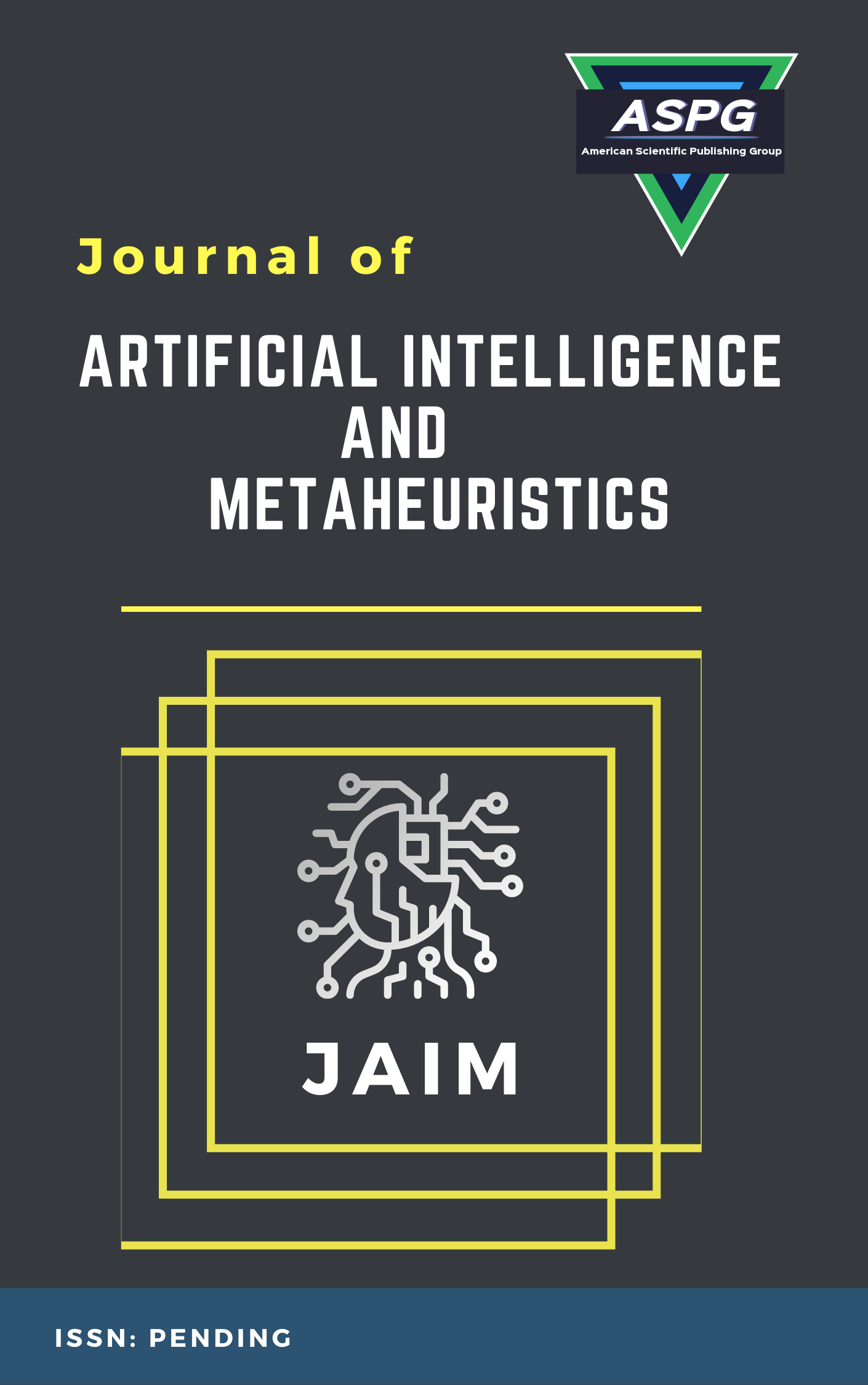

Volume 9 , Issue 1 , PP: 34-43, 2025 | Cite this article as | XML | Html | PDF | Full Length Article
Ahmed Mohamed Zaki 1 * , Shahid Mahmood 2
Doi: https://doi.org/10.54216/JAIM.090104
The study considers the community of ”urban air quality improvement in modern cities” using an extensive dataset obtained from ”Air quality data of Delhi, India” for the period between 25 November 2020 and 24 January 2023. Research aims to significantly reduce air pollutants, including particulate matter, including PM2.5 and PM10, NO2, SO2, CO2, O3, and others. Different machine learning models are being used for airquality level forecasts. Among the models assessed, the Nearest Neighbors algorithm comes out on top and exhibits a very low Mean Squared Error (MSE) of 0.0002. The model’s superb precision is further supported by very low statistics in other key metrics, which confirm the Nearest Neighbors approach to forecasting the quality of air in urban zones. The Nearest Neighbors algorithm is shown to have its place in the application as a tool in the hands of researchers and decision-makers pursuing the fight against air pollution is also a signal of its efficiency and broad applicability. This modeling approach has thus the potential to first identify and later pinpoint localized empirical patterns and statistical dependencies from the data set. Its high predictive precision makes it a very valuable assistant to public health and environmental management, especially so in regions like Delhi.
Air pollutants , K-Nearest Neighbors , Machine Learning Models , Air Quality Prediction.
[1] E. M. Almetwally and M. A. Meraou. Application of environmental data with new extension of nadarajah-haghighi distribution. Computational Journal of Mathematical and Statistical Sciences,
1(1):26–41, 2022.
[2] H. Z. Muhammed and E. M. Almetwally. Bayesian and non-bayesian estimation for the shape parameters of new versions of bivariate inverse weibull distribution based on progressive type ii censoring. Computational Journal of Mathematical and Statistical Sciences, 3(1):85–111, 2024.
[3] Mohammad Reza Shaeri, Soroush Sarabi, Andoniaina M. Randriambololona, and Ameneh Shadlo. Machine learning-based optimization of air-cooled heat sinks. Thermal Science and Engineering Progress, 34:101398, September 2022.
[4] Tianlong Chen, Xiaohan Chen, Wuyang Chen, Howard Heaton, Jialin Liu, ZhangyangWang, andWotaoYin. Learning to Optimize: A Primer and A Benchmark. Journal of Machine Learning Research, 23(189):1–59, 2022.
[5] R. Alotaibi, G. R. AL-Dayian, E. M. Almetwally, and H. Rezk. Bayesian and non-bayesian two-sample prediction for the fr´echet distribution under progressive type ii censoring. AIP Advances, 14(1):015137, 2024.
[6] Wengang Zhang, Xin Gu, Libin Tang, Yueping Yin, Dongsheng Liu, and Yanmei Zhang. Application of machine learning, deep learning and optimization algorithms in geoengineering and geoscience: Comprehensive review and future challenge. Gondwana Research, 109:1–17, September 2022.
[7] Haiping Gao, Shifa Zhong, Wenlong Zhang, Thomas Igou, Eli Berger, Elliot Reid, Yangying Zhao, Dylan Lambeth, Lan Gan, Moyosore A. Afolabi, Zhaohui Tong, Guanghui Lan, and Yongsheng Chen. Revolutionizing Membrane Design Using Machine Learning-Bayesian Optimization. Environmental Science & Technology, 56(4):2572–2581, February 2022. Publisher: American Chemical Society.
[8] Claudio Gambella, Bissan Ghaddar, and Joe Naoum-Sawaya. Optimization problems for machine learning: A survey. European Journal of Operational Research, 290(3):807–828, May 2021.
[9] A. Djaafari, A. Ibrahim, N. Bailek, K. Bouchouicha, and M. A. Hassan. Hourly predictions of direct normal irradiation using an innovative hybrid lstm model for concentrating solar power projects in hyperarid regions. Energy Reports, 8:15548–15562, 2022.
[10] Weiqi Chen, Qi Wu, Chen Yu, Haiming Wang, and Wei Hong. Multibranch Machine Learning-Assisted Optimization and Its Application to Antenna Design. IEEE Transactions on Antennas and Propagation, 70(7):4985–4996, July 2022. Conference Name: IEEE Transactions on Antennas and Propagation.
[11] Rui Ding, Shiqiao Zhang, Yawen Chen, Zhiyan Rui, Kang Hua, Yongkang Wu, Xiaoke Li, Xiao Duan, XuebinWang, Jia Li, and Jianguo Liu. Application of Machine Learning in Optimizing Proton Exchange Membrane Fuel Cells: A Review. Energy and AI, 9:100170, August 2022.
[12] Ryo Tamura, Toshio Osada, Kazumi Minagawa, Takuma Kohata, Masashi Hirosawa, Koji Tsuda, and Kyoko Kawagishi. Machine learning-driven optimization in powder manufacturing of Ni-Co based superalloy. Materials & Design, 198:109290, January 2021.
[13] Shafiqur Rehman, Mohamed E. Zayed, Kashif Irshad, Ahmed S. Menesy, Kotb M. Kotb, Atif Saeed Alzahrani, and Luai M. Alhems. Design, commissioning and operation of a large-scale solar linearFresnel system integrated with evacuated compound receiver: Field testing, thermodynamic analysis, and enhanced machine learning-based optimization. Solar Energy, 278:112785, August 2024.
[14] K. Zhang, J. Th´e, G. Xie, and H. Yu. Multi-step ahead forecasting of regional air quality using spatialtemporal deep neural networks: a case study of huaihai economic zone. Journal of Cleaner Production, 277:123231, 2020.
[15] M. A. A. Al-Qaness, H. Fan, A. A. Ewees, D. Yousri, and M. Abd Elaziz. Improved anfis model for forecasting wuhan city air quality and analysis covid-19 lockdown impacts on air quality. Environmental Research, 194:110607, 2021.
[16] R. Janarthanan, P. Partheeban, K. Somasundaram, and P. Navin Elamparithi. A deep learning approach for prediction of air quality index in a metropolitan city. Sustainable Cities and Society, 67:102720, 2021.
[17] S. Taheri and A. Razban. Learning-based co2 concentration prediction: application to indoor air quality control using demand-controlled ventilation. Building and Environment, 205:108164, 2021.
[18] Y. Huang, J. J.-C. Ying, and V. S. Tseng. Spatio-attention embedded recurrent neural network for air quality prediction. Knowledge-Based Systems, 233:107416, 2021.
[19] D. Jia, L. Yang, T. Lv, W. Liu, and X. Gao. Evaluation of machine learning models for predicting daily global and diffuse solar radiation under different weather/pollution conditions. Renewable Energy, 187:896–906, 2022.
[20] G. Ferdinands, R. Schram, J. de Bruin, A. Bagheri, and D. L. Oberski. Performance of active learning models for screening prioritization in systematic reviews: a simulation study into the average time to discover relevant records. Systematic Reviews, 12(1):100, 2023.
[21] V. Plevris, G. Solorzano, N. P. Bakas, and M. E. A. Ben Seghier. Investigation of performance metrics in regression analysis and machine learning-based prediction models, 2022.